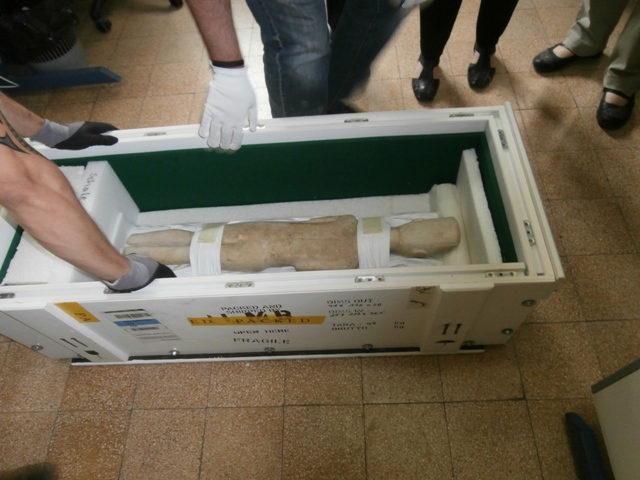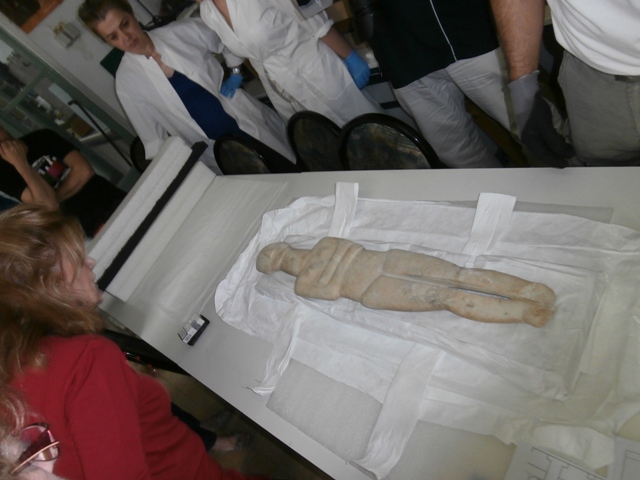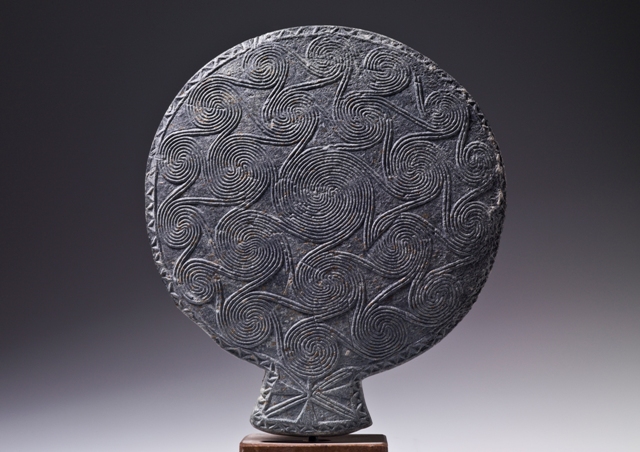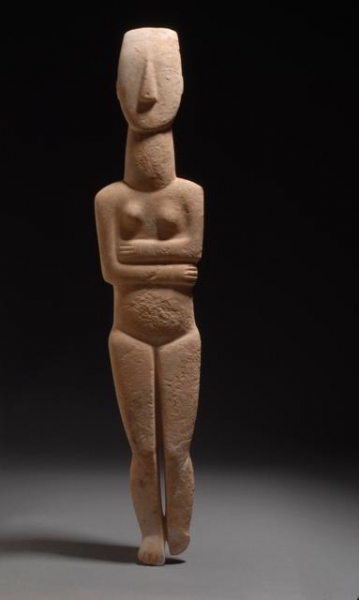Anastasia Balezdrova
From today onwards, two typical examples of the early Cycladic civilization will be displayed in the hall of the altar of the Greek National Archaeological Museum. A female figure and a vessel in the shape of a pan, which until recently were among the exhibits of the Baden Museum in Karlsruhe, within a few months will become part of the permanent exhibition of artefacts of the Cycladic civilization in Greece's largest museum.
The exhibits were presented at a ceremony attended by the Ministers of Culture of Greece and the state of Baden-Württemberg and representatives of the two museums. They announced that the statue and the vessel would be returned having spent 38 years in Karlsruhe, reaffirming their willingness to continue their efforts for the return of archaeological finds to the places at which they were created and from which they were illegally taken.

The marble idol with a height of about 90 cm is a female figure with folded hands under her breasts. Archaeologists believe it was created in the period 2800-2300 BC in the region of Naxos Island. It is one of the largest-sized statues that have survived to this day. One can notice the ears, nose, eyes and eyebrows, the fingers and toes, and the femininity of the breasts and abdomen are clearly distinguished. There are still traces of the hair and eye colour on the statue.
Archaeologists have not yet determined the purpose of Cycladic idols. The fact that they were found in tombs probably proves their use as funerary objects and the beliefs in afterlife. The large size of this idol may be associated with its use as a cult statue.

The second artefact is a vessel in the shape of a frying pan with a diameter of 18 cm. It is believed that it was created during the same period, again on Naxos Island. It is decorated with embossed interlocking spirals that are a very popular element in the art of the early Cycladic civilization. The edge of the vessel is decorated with a zigzag line and its handle with an unusual motif in the shape of a cross, consisting of triangles and double lines. Such decoration can be seen on compasses found in the region of Dokatismata on Amorgos Island, of Naxos Island and Daskalio isle.

The vessel is one of the few stone vessels in the shape of a pan, which are usually made of clay and is the only one made of chlorite shale. Similar vessels have been found in graves, but not in the remains of settlements. It is not yet clear what they were used for. The assumptions vary as follows: they were vessels used for offerings for the dead or for storing the toiletries of the deceased person such as mirrors; funeral drums, equipment for orientation and navigation, vessels to transport salt, containers for religious practices in honour of the sea or the sun that were the main elements in the life of the first inhabitants of the Cyclades.
According to the director of the Ancient Artefacts and Cultural Heritage Department of the Greek Ministry of Culture Maria Andreadaki - Vlazaki, mass illegal excavations of graves took place on the Cycladic islands in the 1960s in order to sell the artefacts found to museums, private collectors and auction houses in North America.
 "In the early 1970s, the director of the Baden Museum at the time bought some of them from a Swiss antiquarian, following the vicious practice of the time. The statue and the vessel were displayed in the museum windows and participated in exhibitions and catalogues for 38 years."
"In the early 1970s, the director of the Baden Museum at the time bought some of them from a Swiss antiquarian, following the vicious practice of the time. The statue and the vessel were displayed in the museum windows and participated in exhibitions and catalogues for 38 years."
Vlazaki expressed gratitude to the German museum for having presented the works of the Cycladic civilization to its visitors, thereby introducing them to many people from around the world. At the same time, however, she added, "Fortunately, at the same time, the attitude towards this way of obtaining artefacts began to change. The foundations were laid by the UNESCO Convention on the Protection of the World Cultural and Natural Heritage that was signed in 1970, which was followed by European legislation in this area."
In order to strongly oppose the display of stolen and smuggled Greek artefacts by foreign museums, the Greek Ministry of Culture often refused to participate in various exhibitions. "Thus we were able to show the severity of the problem, attract the attention of our colleagues from other countries and ultimately to find a common solution as in the case of the Baden Museum," added Vlazaki.
Museum archaeologist Katharina Horst and Deputy Secretary of Culture and Science in Baden-Wuerttemberg Jürgen Walter stressed that they are pleased to return the two valuable samples of the Cycladic civilization because they firmly believe that this is the right approach.
"They ended up in the museum in Karlsruhe in very "dark" ways. The refusal of the Greek Ministry of Culture to join one of our exhibitions was the reason to consider their return to the country where they were created. Personally, I perceive as fully tenable the criticism that we were made. Therefore, today we are here to celebrate the return of the two artefacts to Greece," said Walter in his speech.
Then he and Greek Minister of Culture Panos Panagiotopoulos signed a cooperation agreement for the return of artefacts that have been illegally exported from Greece.